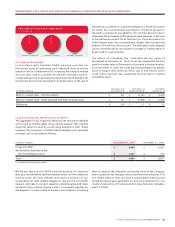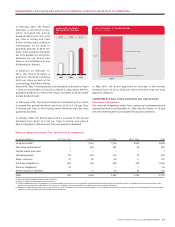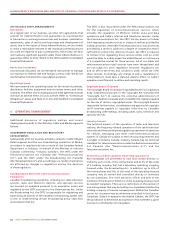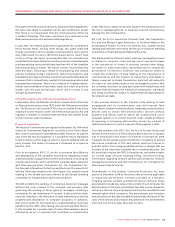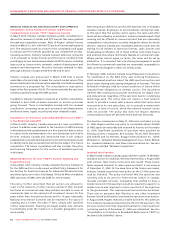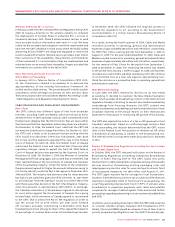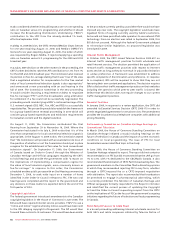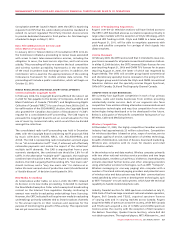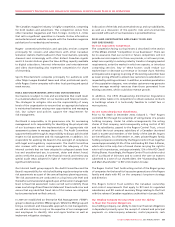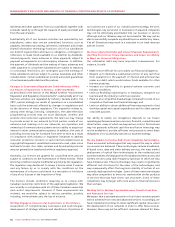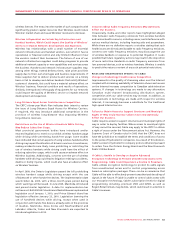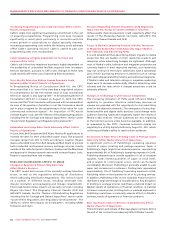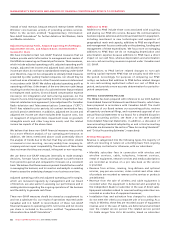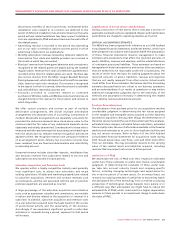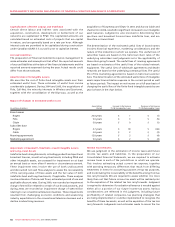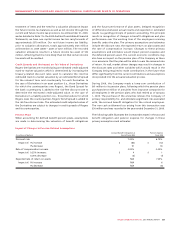Rogers 2009 Annual Report Download - page 55
Download and view the complete annual report
Please find page 55 of the 2009 Rogers annual report below. You can navigate through the pages in the report by either clicking on the pages listed below, or by using the keyword search tool below to find specific information within the annual report.
ROGERS COMMUNICATIONS INC. 2009 ANNUAL REPORT 59
MANAGEMENT’S DISCUSSION AND ANALYSIS OF FINANCIAL CONDITION AND RESULTS OF OPERATIONS
The Canadian magazine industry is highly-competitive, competing
for both readers and advertisers. This competition comes from
other Canadian magazines and from foreign, mostly U.S., titles
that sell in significant quantities in Canada. Online information
and entertainment websites compete with the Canadian magazine
publications for readership and revenue.
Rogers’ conventional television and specialty services compete
principally for viewers and advertisers with other Canadian
television stations that broadcast in their local markets, specialty
channels and increasingly with other distant Canadian signals
and U.S. border stations given the time-shifting capacity available
to digital subscribers. Internet information and entertainment
and video downloading also represent competition for share
of viewership.
Sports Entertainment competes principally for audiences with
other Major League Baseball teams and other professional sports,
while Rogers Centre competes with other local sporting and special
event venues.
RISKS AND UNCERTAINTIES AFFECTING OUR BUSINESSES
Our business is subject to risks and uncertainties that could result
in a material adverse effect on our business and financial results.
The strategies to mitigate risks are the responsibility of many
levels of the organization to ensure that an appropriate balance
is maintained between seizing new opportunities and managing
risk. Our culture and policies support the requirement for
risk management.
Our Board is responsible, in its governance role, for overseeing
management in its responsibility for identifying the principal risks
of our businesses and the implementation of appropriate risk
assessment systems to manage these risks. The Audit Committee
supports the Board through its responsibility to discuss policies with
respect to risk assessment and risk management. In addition, it is
responsible for assisting the Board in the oversight of compliance
with legal and regulatory requirements. The Audit Committee
also reviews with senior management the adequacy of the
internal controls that we have adopted to safeguard assets from
loss and unauthorized use, to prevent, deter and detect fraud,
and to verify the accuracy of the financial records and review any
special audit steps adopted in light of material weaknesses or
significant deficiencies.
Our Internal Audit group supports the Audit Committee and the
Board’s responsibility for risk by facilitating regular enterprise wide
risk assessments as a part of the annual business planning process.
The risk assessments are conducted on a business unit level and
thereafter summarized and agreed upon at the senior management
level. A fraud risk assessment is also carried out to identify those
areas in which significant financial statement fraud could occur and
ensure that any identified fraud risks of this nature are mitigated
by documented and verified controls.
In 2009 we established an Enterprise Risk Management (“ERM”)
group to develop a holistic ERM program. While the ERM group will
bring a consistent and measurable approach to risk management,
we will also continue to rely on the expertise of our management
and employees to identify risks and opportunities as well as
implement mitigation strategies.
A discussion of the risks and uncertainties to us and our subsidiaries,
as well as a discussion of the specific risks and uncertainties
associated with each of our businesses, is presented below.
RISKS AND UNCERTAINTIES APPLICABLE TO RCI AND
OUR SUBSIDIARIES
We Face Substantial Competition.
The competition facing our businesses is described in the section
of this MD&A entitled “Competition in our Businesses”. There can
be no assurance that our current or future competitors will not
provide services superior to those we provide, or at lower prices,
adapt more quickly to evolving industry trends or changing market
requirements, enter the market in which we operate, or introduce
competing services. Any of these factors could reduce our
market share or decrease our revenue or increase churn. Wireless
anticipates some ongoing re-pricing of the existing subscriber base
as lower pricing offered to attract new customers is extended to or
requested by existing customers. In addition, as wireless penetration
of the population deepens, new wireless customers may generate
lower average monthly revenues than those generated from
existing customers, which could slow revenue growth.
In addition, the CRTC Broadcasting Distribution Regulations
do not allow Cable or its competitors to obtain exclusive contracts
in buildings where it is technically feasible to install two or
more systems.
We Are Controlled by One Shareholder.
Prior to his death in December 2008, Edward S. “Ted” Rogers
controlled RCI through his ownership of voting shares of a private
holding company. Under his estate arrangements, the voting
shares of that company, and consequently voting control of RCI
and its subsidiaries, passed to the Rogers Control Trust, a trust
of which the trust company subsidiary of a Canadian chartered
bank is trustee and members of the family of the late Mr. Rogers
are beneficiaries. As of December 31, 2009, private Rogers family
holding companies controlled by the Rogers Control Trust together
owned approximately 90.9% of the outstanding RCI Class A Shares,
which class is the only class of issued shares carrying the right to
vote in all circumstances, and approximately 7.5% of the RCI Class B
Voting Shares. Accordingly, the Rogers Control Trust is able to elect
all of our Board of Directors and to control the vote on matters
submitted to a vote of our shareholders. See “Outstanding Shares
and Main Shareholder” in RCI’s Information Circular.
The Rogers Control Trust holds voting control of the Rogers group
of companies for the benefit of successive generations of the Rogers
family and deals with RCI on the company’s long-term strategy
and direction.
The Rogers Control Trust satisfies the Canadian ownership
and control requirements that apply to RCI and its regulated
subsidiaries, and RCI made all necessary filings relating to the Trust
with the relevant Canadian regulatory authorities in January 2009.
Our Holding Company Structure May Limit Our Ability
to Meet Our Financial Obligations.
As a holding company, our ability to meet our financial obligations
is dependent primarily upon the receipt of interest and principal
payments on intercompany advances, rental payments, cash


